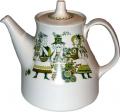Darjeeling Tea is one of the world's most expensive teas. Traditionally known as the "champagne of teas", it is only grown, cultivated and processed in the hilly areas of Darjeeling district in West Bengal, India. There are 86 Tea Estates within that area, and only tea from these estates may be called Darjeeling Tea.
Darjeeling Tea is known for its distinctive aroma and fragrance. There are four varieties of Darjeeling Tea, but generally Darjeeling Tea has a spicy and muscatel (grape-like) taste. The muscatel quality is one of Darjeeling Tea's most famed qualities.
Varieties of darjeeling tea
Darjeeling Tea can come in four varieties, according to its season of harvesting.
The first variety is known as Easter Flush. This variety features tender, light-green leaves. The tea is known for its light appearance and brisk flavor. It is harvested from March to April.
The second variety is known as the Spring Flush. This variety is characterized by its purple bloom. It has an amber appearance and a slight fruit taste. Cultivated from May to June, tea from this harvest is known for its strong muscatel flavor.
Summer Flush is harvested from July to September. This variety is the strongest of the Darjeeling Tea varieties. Despite its strong flavor, the tea maintains the brightness of the other varieties.
The last variety is Autumn Flush, which is harvested from October to November. The Darjeeling Tea harvested in this period is known for its copper tinge and delicate taste.
Darjeeling Tea is not produced during winter.
Preparing darjeeling tea
Enjoying the full taste of Darjeeling Tea is a simple process. Simply place one tablespoon of Darjeeling Tea into a cup, and pour boiling water on top. Allow the tea to brew for three to four minutes. Darjeeling Tea can be drunk by itself, or with milk and sugar.
If milk and sugar are to be added, the tea should be allowed to brew for five minutes.
Darjeeling Tea can also be cooled and used as ice tea. When used as iced tea, a slice of lemon is recommended as a compliment.
Identifying genuine darjeeling tea
In the modern world of global tea trading, falsification is a serious problem facing both growers and buyers. The yearly worldwide trade of tea named as Darjeeling exceeds 40,000 tonnes annually, yet the production of genuine Darjeeling tea is approximately 8,000 to 11,0000 tonnes.
Therefore, to ensure that the tea is genuine Darjeeling Tea, the tea must be marked by the Darjeeling Logo. The Darjeeling Logo is a green circular marking, with the image of a Nepalese woman tea plucker on the right side and the word "Darjeeling" on the upper left section. This is to symbolize the fact that all Darjeeling tea is plucked by Nepalese women.
